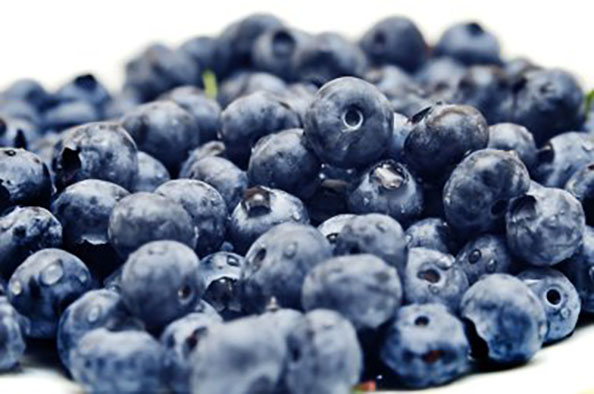Blueberries as we know them were born in New Jersey. Those plump, juicy, sweet summer essentials owe their existence to the Pine Barrens; the same place where we find cranberry bogs and the legend of the Jersey Devil.
Even without the local connection, blueberries are worth celebrating. Not only can they be as sweet as candy when at perfect ripeness, they are rich in antioxidants, vitamins and fiber, which supports heart health, brain function, and the immune system – all making them worthy of the National Blueberry Day observation coming up July 8.
The success of the blueberry here isn’t only the work of Mother Nature. Yes they love the combination of sandy, acidic, low pH soil found in the Pine Barrens; but the highbush blueberry plant was willed into existence on its journey to becoming the state fruit, and one of New Jersey’s foremost agricultural success stories.
As far back as 1887, Elizabeth White, a botanist born in Pemberton, Burlington County, was searching for a secondary crop to grow on her father’s cranberry farm. One idea was blueberries, which grew in the wild but were too sour and unreliable to be consistently reproduced in a commercially viable way.
After reading about his work, White collaborated with USDA botanist Frederick Coville in 1911, who at the time was also trying to come up with a viable blueberry.
White invited Coville to her father’s Whitesbog, Burlington County, farm and they went to work. With the help of local residents, they hunted down as many wild berry bushes as they could, and started cross-breeding new varieties.
“Elizabeth would pay those who brought her blueberry bushes, compensating for the time taken to collect them in addition to the bush itself,” according to the New Jersey Agricultural Society. “All new varieties that were created were named after who delivered the bush.”
By 1916 they were ready to put a product on the market. As time went on they released numerous varieties and their popularity grew among farmers and consumers. They even created an incentive program that rewarded farmers for reporting data on their crops.
Not only was the cultivated blueberry first perfected in the Garden State, today we’re the seventh highest ranking state in the nation for blueberry production at just over 50.2 million pounds per year ($92.1 million worth) – quite an achievement for the fifth smallest state in the union.
New Jersey blueberries are sold down in Texas and all the way up in Canada, throughout the Midwest and the entire East Coast, according to Denny Doyle, a blueberry farmer and chairman of the New Jersey Blueberry Advisory Council, which supports and promotes the industry in the state.
With the season running mid-June through August, the 2025 crop is well underway. It means shelves will be well-stocked for the 39th Annual Red White and Blueberry Festival in Hammonton Sunday, June 29.
The self-proclaimed Blueberry Capital of the World will celebrate from 10 a.m. to 4 p.m. at Hammonton High School with live music, vendors, a car show, rides for the kids and of course, blueberries prepared in every way. Follow the signs for free remote parking.
Doyle noted that Hammonton grew more peaches until the mid-1960s when farmers realized the berry was a more economical choice.
On National Blueberry Day, Tuesday, July 8, there will be another blueberry event, this one designed exclusively for families with children on the autism spectrum.
Johnny Boy Blues blueberry farm in Egg Harbor City will host National Blueberry Day with Heart of Surfing. Celebrate from 6 to 8 p.m. at 347 S. Vienna Ave., Egg Harbor City, for an evening of blueberry picking, pizza, live music, family activities, local vendors, and a special flyover by the New Jersey State Police.
“We’re passionate about growing blueberries and supporting the autism community,” said Amy Hunter who owns the farm with her husband, Chris. The farm is named for her son who has autism. “I hope to keep this farm in our family and bless others through it,” Hunter said,
“For the past four years, we have had an event at our farm on July 8,” said Hunter, who inherited the 80-acre farm from her parents. “It’s always July 8 because that’s National Blueberry Day, and it’s my mom’s birthday.” RSVP now at heartofsurfing.org. click on “Events.”
Historic Whitesbog Farm and Village in Browns Mills holds a Blueberry Summer Fest 4-9 p.m. each Friday, June 13-July 25; excluding July 4 and including Saturday, July 5, 10 a.m. 2 p.m. Learn more at whitesbog.org.
In New Jersey, blueberries are grown on approximately 250 of the state’s 9,100 farms, spanning over 10,800 acres, with most growing in Atlantic County, particularly around Hammonton and Burlington County, according to the USDA. Doyle said most of the Atlantic County farms are larger than the ones in Burlington.
As far as the 2025 season is concerned we are well into it and things are looking good.
“New Jersey blueberries are here and they are in the supermarkets now,” said Doyle. “We are picking at a high level. We are peaking at this point in time in terms of volume, things are looking very good.”
It all comes together through an intricate combination of collaboration, science, and a finely tuned marketplace that assures that output finds its way to customers efficiently.
When it comes to selling blueberries, it’s all about supply and demand and what the major buyers like Walmart, Costco, and SuperFresh are willing to pay. Farmers need to have a feel for just how much of their crop should be picked for the fresh or frozen market. It also helps that farmers are supportive of eachother.

“In New Jersey we have a very close-knit group. Our communications between growers and growing organizations are just excellent, probably some of the best in the United States as far as unity, talking about our volume levels where the general pricing is,” said Doyle, who noted that they’re also pretty competitive.
As important as all that is, how the general demand is, also called “the take,” Is crucial.
“And right now, the take, the demand, is good. It’s real good. We have the Fourth of July coming up. And that’s obviously a big holiday for us. And New Jersey is positioned to really handle that Fourth of July celebration. So we’re connected right at the hip with that holiday.”
That’s a good thing because blueberries have to move.
“We’re not dealing with cranberries where you have maybe a week or two, and sometimes even three weeks to move your volume. Blueberries, we want to see done within four or five days.
“But (if a farmer) has a lot of blue fruit out there in a field that is not a you-pick farm, that’s when he’s got the decision, okay, let’s freeze, for example, 20% of what we’re bringing in, and we’ll pack fresh 80%. Sometimes it’s 50-50.” Doyle said doing it right it’s like an art form.
“It depends on the demand or the margins.”
When you get down to it, blueberries may be small, but they are a big deal and Atlantic County should feel proud and privileged to be at the center of it all.
Copy editor and Contributing Writer James FitzPatrick has been a community journalist in Atlantic and Cape May counties for more than 30 years, including 20 years as editor of The Current Newspapers. He lives in Hammonton.
















